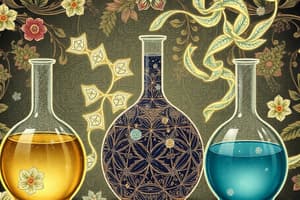Podcast
Questions and Answers
What distinguishes a compound from an element?
What distinguishes a compound from an element?
- A compound is formed when different types of atoms chemically combine. (correct)
- A compound can exist in multiple physical forms, unlike an element.
- A compound is a single atom, while an element is made of multiple atoms.
- A compound retains the properties of its constituent elements.
Which of the following correctly describes a heterogeneous mixture?
Which of the following correctly describes a heterogeneous mixture?
- It forms a single phase in all conditions.
- It contains physically distinct substances that can be separated. (correct)
- It exhibits uniform composition throughout.
- It contains particles that are chemically identical.
What is the defining characteristic of an allotrope?
What is the defining characteristic of an allotrope?
- Allotropes are distinct structural forms of the same element. (correct)
- Allotropes are characterized by a change in chemical composition.
- Allotropes can only exist in gaseous states.
- Allotropes must consist of more than one type of atom.
Which of these statements about mixtures is accurate?
Which of these statements about mixtures is accurate?
What type of bonding is predominant in graphite?
What type of bonding is predominant in graphite?
Which statement about elements is incorrect?
Which statement about elements is incorrect?
Which of the following represents a colloid?
Which of the following represents a colloid?
What happens during a chemical change?
What happens during a chemical change?
Which of the following is an example of a pure substance?
Which of the following is an example of a pure substance?
Which characteristic is true for homogeneous mixtures?
Which characteristic is true for homogeneous mixtures?
Flashcards are hidden until you start studying
Study Notes
Introduction to Chemistry
- Chemistry studies matter, which has mass and occupies space.
- Examples of matter include air, water, rocks, and living organisms.
- Matter is composed of atoms, the fundamental building blocks of all substances.
States of Matter
- Matter exists in four distinct states: gas, liquid, solid, and plasma.
- States are determined by particle arrangement, movement, and the strength of intermolecular forces.
- Energy influences state changes: heating solids turns them into liquids or gases; high temperatures or strong electric fields can convert gases into plasma.
- Crystalline solids can become cloudy liquids known as liquid crystals, which exhibit properties of both solids and liquids within a certain temperature range.
- Bose-Einstein Condensates (BEC) occur at near absolute zero temperatures, observable under extreme conditions, and include superfluids and superconductors.
Macroscopic Properties of Matter
- Macroscopic properties include density, fluidity, and compressibility.
- Density varies across states: gases have low density, liquids and solids have high density.
- Compressibility differs: gases are highly compressible, liquids moderately, and solids are not compressible.
- Fluidity is present in gases and liquids, but solids cannot flow.
Chemical Changes and Physical Techniques
- States of matter can be transformed through physical techniques (temperature/pressure adjustments) without altering chemical composition.
- Observations during boiling (like water forming bubbles) exemplify state changes.
Classification of Matter
- Matter can be classified into pure substances (elements and compounds) or mixtures.
- Elements: Simplest form of matter with atoms having the same atomic number (proton number); cannot be chemically broken down.
- Compounds: Substances formed when two or more different elements chemically combine, resulting in new properties.
- Mixtures: Physical combinations of substances; can be homogeneous (uniform) or heterogeneous (non-uniform).
- Examples of heterogeneous mixtures include colloids and suspensions.
Allotropes
- Allotropes are different physical forms of the same element, with atoms arranged differently.
- Carbon allotropes include diamond, graphite, and buckyballs.
- Graphite: Contains two-dimensional layers of hexagonally arranged carbon atoms, bonded covalently within layers and held by weak intermolecular forces, allowing the layers to slide over one another.
Studying That Suits You
Use AI to generate personalized quizzes and flashcards to suit your learning preferences.




